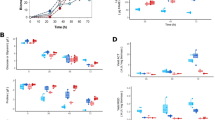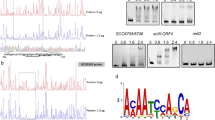Abstract
To seek more information on function of two-component regulatory systems (TCSs) in Streptomycescoelicolor, a dozen TCS-knockout mutants were generated, and phenotype changes were determined. One TCS (SCO5403/5404)-deleted mutant with phenotype change was obtained. Here, we report the characterization of this novel TCS, designated as RapA1/A2 (regulation of both actinorhodin and a type I polyketide), using genetic and proteomic approaches. Although growth and morphological analyses showed no difference between the knockout mutant and wild-type strain M145, a visible decrease of the production of actinorhodin (Act) was observed in rapA1/A2 mutant. The decrease can be restored by introducing rapA1/A2 genes on an integrative vector. A 2D-gel based proteomic analysis showed that knockout of rapA1/A2 resulted in reduced expression of a putative 3-oxoacyl-[acyl-carrier protein] reductase that is part of a biosynthetic cluster for a cryptic type I polyketide. Further reverse-transcriptase-polymerase chain reaction (RT-PCR) analyses confirmed that expression levels of several biosynthetic genes and the respective pathway-specific regulatory genes actII-ORF4 and kasO for these two clusters were all down-regulated in the rapA1/A2 mutant, compared to M145. Taken together, the results demonstrated that RapA1/A2 may serve as a positive regulator for biosynthesis of both Act and the uncharacterized polyketide in S. coelicolor, and the effects exerted by RapA1/A2 were dependent on the pathway-specific regulatory genes.





Similar content being viewed by others
References
Aceti DJ, Champness WC (1998) Transcriptional regulation of Streptomyces coelicolor pathway-specific antibiotic regulators by the absA and absB loci. J Bacteriol 180:3100–3106
Adamidis T, Riggle P, Champness W (1990) Mutations in a new Streptomyces coelicolor locus which globally block antibiotic biosynthesis but not sporulation. J Bacteriol 172:2962–2969
Anderson TB, Brian P, Champness WC (2001) Genetic and transcriptional analysis of absA, an antibiotic gene cluster-linked two-component system that regulates multiple antibiotics in Streptomyces coelicolor. Mol Microbiol 39:553–566
Bentley SD, Chater KF, Cerdeno-Tarraga AM, Challis GL, Thomson NR, James KD, Harris DE, Quail MA, Kieser H, Harper D, Bateman A, Brown S, Chandra G, Chen CW, Collins M, Cronin A, Fraser A, Goble A, Hidalgo J, Hornsby T, Howarth S, Huang CH, Kieser T, Larke L, Murphy L, Oliver K, O’Neil S, Rabbinowitsch E, Rajandream MA, Rutherford K, Rutter S, Seeger K, Saunders D, Sharp S, Squares R, Squares S, Taylor K, Warren T, Wietzorrek A, Woodward J, Barrell BG, Parkhill J, Hopwood DA (2002) Complete genome sequence of the model actinomycete Streptomyces coelicolor A3(2). Nature 417:141–147
Bibb MJ (2005) Regulation of secondary metabolism in streptomycetes. Curr Opin Microbiol 8:208–215
Bijlsma JJ, Groisman EA (2003) Making informed decisions: regulatory interactions between two-component systems. Trends Microbiol 11:359–366
Chang HM, Chen MY, Shieh YT, Bibb MJ, Chen CW (1996) The cutRS signal transduction system of Streptomyces lividans represses the biosynthesis of the polyketide antibiotic actinorhodin. Mol Microbiol 21:1075–1085
Demain AL (1999) Pharmaceutically active secondary metabolites of microorganisms. Appl Microbiol Biotechnol 52:455–463
Gramajo HC, Takano E, Bibb MJ (1993) Stationary-phase production of the antibiotic actinorhodin in Streptomyces coelicolor A3(2) is transcriptionally regulated. Mol Microbiol 7:837–845
Gust B, Challis GL, Fowler K, Kieser T, Chater KF (2003) PCR-targeted Streptomyces gene replacement identifies a protein domain needed for biosynthesis of the sesquiterpene soil odor geosmin. Proc Natl Acad Sci USA 100:1541–1546
Hesketh AR, Chandra G, Shaw AD, Rowland JJ, Kell DB, Bibb MJ, Chater KF (2002) Primary and secondary metabolism, and post-translational protein modifications, as portrayed by proteomic analysis of Streptomyces coelicolor. Mol Microbiol 46:917–932
Hodgson DA (2000) Primary metabolism and its control in streptomycetes: a most unusual group of bacteria. Adv Microbial Physiol 42:47–238
Hong HJ, Paget MSB, Buttner MJ (2002) A signal transduction system in Streptomyces coelicolor that activates the expression of a putative cell wall glycan operon in response to vancomycin and other cell wall-specific antibiotics. Mol Microbiol 44:1199–1211
Hopwood DA (1997) Genetic contributions to understanding polyketide synthases. Chem Rev 97:2465–2497
Hopwood DA (1999) Forty years of genetics with Streptomyces: from in vivo through in vitro to in silico. Microbiology 145:2183–2202
Hutchings MI, Hoskisson PA, Chandra G, Buttner MJ (2004) Sensing and responding to diverse extracellular signals? Analysis of the sensor kinases and response regulators of Streptomyces coelicolor A3(2). Microbiology 150:2795–2806
Ishizuka H, Horinouchi S, Kieser HM, Hopwood DA, Beppu T (1992) A putative 2-component regulatory system involved in secondary metabolism in Streptomyces spp. J Bacteriol 174:7585–7594
Katz L (1997) Manipulation of modular polyketide synthases. Chem Rev 97:2557–2576
Khosla C, Gokhale RS, Jacobsen JR, Cane DE (1999) Tolerance and specificity of polyketide synthases. Ann Rev Biochem 68:219–253
Kieser T, Bibb MJ, Buttner MJ, Chater KF, Hopwood DA (2000) Practical Streptomyces Genetics. The John Innes Foundation, Norwich
Kim D, Forst S (2001) Genomic analysis of the histidine kinase family in bacteria and archaea. Microbiology 147:1197–1212
Kormanec J, Sevcikova B, Homerova D (2000) Cloning of a two-component regulatory system probably involved in the regulation of chitinase in Streptomyces coelicolor A3(2). Folia Microbiol 45:397–406
Levdikov VM, Blagova EV, Brannigan JA, Wright L, Vagin AA, Wilkinson AJ (2005) The structure of the oligopeptide-binding protein, AppA, form Bacillus subtilis in complex with a nonapeptide. J Mol Biol 345:879–892
Li YQ, Chen PL, Chen SF, Wu D, Zheng J (2004) A pair of two-component regulatory genes ecrA1/A2 in Streptomyces coelicolor. J Zhejiang Univ Sci 5:173–179
Novotna J, Vohradsky J, Berndt P, Gramajo H, Langen H, Li XM, Minas W, Orsaria L, Roeder D, Thompson CJ (2003) Proteomic studies of diauxic lag in the differentiating prokaryote Streptomyces coelicolor reveal a regulatory network of stress-induced proteins and central metabolic enzymes. Mol Microbiol 48:1289–1303
Ogura M, Tanaka T (2002) Recent progress in Bacillus subtilis two-component regulation. Fron Biosci 7:d1815–d1824
Okamoto S, Lezhava A, Hosaka T, Okamoto-Hosoya Y, Ochi K (2003) Enhanced expression of S-adenosylmethionine synthetase causes overproduction of actinorhodin in Streptomyces coelicolor A3(2). J Bacteriol 185:601–609
Paget MSB, Leibovitz E, Buttner MJ (1999) A putative two-component signal transduction system regulates sigma(E), a sigma factor required for normal cell wall integrity in Streptomyces coelicolor A3(2). Mol Microbiol 33:97–107
Park HS, Shin SK, Yang YY, Kwon HJ, Suh JW (2005) Accumulation of S-adenosylmethionine induced oligopeptide transporters including BldK to regulate differentiation events in Streptomyces coelicolor M145. FEMS Microbiol Lett 249:199–206
Redenbach M, Kieser HM, Denapaite D, Eichner A, Cullum J, Kinashi H, Hopwood DA (1996) A set of ordered cosmids and a detailed genetic and physical map for the 8 Mb Streptomyces coelicolor A3(2) chromosome. Mol Microbiol 21:77–96
Ryding NJ, Anderson TB, Champness WC (2002) Regulation of the Streptomyces coelicolor calcium-dependent antibiotic by absA, encoding a cluster-linked two-component system. J Bacteriol 184:794–805
Sheeler NL, MacMillan SV, Nodwell JR (2005) Biochemical activities of the absA two-component system of Streptomyces coelicolor. J Bacteriol 187:687–696
Shima J, Hesketh A, Okamoto S, Kawamoto S, Ochi K (1996) Induction of actinorhodin production by rpsL (encoding ribosomal protein S12) mutations that confer streptomycin resistance in Streptomyces lividans and Streptomyces coelicolor A3(2). J Bacteriol 178:7276–7284
Sola-Landa A, Moura RS, Martin JF (2003) The two-component PhoR-PhoP system controls both primary metabolism and secondary metabolite biosynthesis in Streptomyces lividans. Proc Natl Acad Sci USA 100:6133–6138
Takano E, Gramajo HC, Strauch E, Andres N, White J, Bibb MJ (1992) Transcriptional regulation of the redD transcriptional activator gene accounts for growth-phase-dependent production of the antibiotic undecylprodigiosin in Streptomyces coelicolor A3(2). Mol Microbiol 6:2797–2804
Takano E, Nihira T, Hara Y, Jones JJ, Gershater CJL, Yamada Y, Bibb M (2000) Purification and structural determination of SCB1, a gamma-butyrolactone that elicits antibiotic production in Streptomyces coelicolor A3(2). J Biol Chem 275:11010–11016
Takano E, Chakraburtty R, Nihira T, Yamada Y, Bibb MJ (2001) A complex role for the gamma-butyrolactone SCB1 in regulating antibiotic production in Streptomyces coelicolor A3(2). Mol Microbiol 41:1015–1028
Takano E, Kinoshita H, Mersinias V, Bucca G, Hotchkiss G, Nihira T, Smith CP, Bibb M, Wohlleben W, Chater K (2005) A bacterial hormone (the SCB1) directly controls the expression of a pathway-specific regulatory gene in the cryptic type I polyketide biosynthetic gene cluster of Streptomyces coelicolor. Mol Microbiol 56:465–479
Watanabe W, Sampei G, Aiba A, Mizohuchi K (1989) Identification and sequence analysis of Escherichia colipurE and purK genes encoding 5′-phophoribosyl-5-amino-4-imidazole carboxylase for de novo purine biosynthesis. J Bacteriol 171:198–204
Wu G, Culley DE, Zhang WW (2005) Predicted highly expressed genes in the genomes of Streptomyces coelicolor and Streptomyces avermitilis and the implications for their metabolism. Microbiology 151:2175–2187
Zhou X, Cahoon M, Rosa P, Hedstrom L (1997) Expression, purification, and characterization of inosine 5’-monophosphate dehydrogenase from Borrelia burgdorferi. J Biol Chem 272:21977–21981
Acknowledgements
We are grateful to the Research Center for Proteome Analysis, Shanghai Institutes for Biological Sciences, Chinese Academy of Sciences for helps with 2D-PAGE and MOLDI-TOF analyses, and to Professor Keith Chater for kindly providing S. coelicolor cosmid 8F4, and all of the plasmids and strains used in PCR-targeting system.
This work was supported by National Natural Science Foundation of China (30470029), National Basic Research Program of China (2007CB707803) and the Knowledge Innovation Program of the Chinese Academy of Sciences (KSCX2-YW-G-007).
Author information
Authors and Affiliations
Corresponding author
Electronic supplementary material
Rights and permissions
About this article
Cite this article
Lu, Y., Wang, W., Shu, D. et al. Characterization of a novel two-component regulatory system involved in the regulation of both actinorhodin and a type I polyketide in Streptomyces coelicolor . Appl Microbiol Biotechnol 77, 625–635 (2007). https://doi.org/10.1007/s00253-007-1184-5
Received:
Revised:
Accepted:
Published:
Issue Date:
DOI: https://doi.org/10.1007/s00253-007-1184-5




